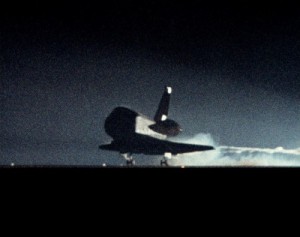
Columbia swoops like a bird of prey into Edwards Air Force Base on 18 January 1986, just 10 days ahead of the Challenger tragedy. Commander Robert “Hoot” Gibson would later refer to this mission as “The End of Innocence” … for after Challenger the shuttle program would never be the same again (Credits: NASA).
January 1986 has become entrenched in the popular psyche as one of the darkest months in space history, for on its 28th day the crew of Challenger were lost in the skies above Cape Canaveral. The disaster would bring the shuttle program to its knees for almost three years, but earlier that month another team of astronauts—the crew of Mission 61C, aboard Columbia—narrowly escaped a meeting with their maker. Their flight had been postponed since before Christmas 1985, and one of the astronauts was the unlucky Steve Hawley, who had endured the first shuttle pad abort a year earlier. His NASA crewmates were Robert “Hoot” Gibson in command, joined by pilot Charlie Bolden and mission specialists George “Pinky” Nelson and Franklin Chang-Diaz. They would also be joined by a pair of payload specialists, whose identities remained in flux until shortly before launch.
The Mission
Originally scheduled to fly in August 1985, they were meant to deploy two communications satellites—ASC-1 for the American Satellite Company and Syncom 4-4 for the U.S. Navy—and operate a Materials Science Laboratory (MSL-2) in the payload bay. However, by March 1985 their mission slipped into January 1986 and was redesignated 51L. In their “new” incarnation, the crew would deploy a large Tracking and Data Relay Satellite for NASA and the Spartan-203 free-flier to observe Halley’s Comet. Then, in July, they received the new designation of 61C, gained two other communications satellites, and picked up payload specialist Bob Cenker from the Radio Corporation of America (RCA).
Cenker was an electrical and aerospace engineer who served as a senior staff engineer with RCA Astro Electronics (bought by General Electric in 1986 to become GE AstroSpace) and had worked extensively on several communications satellite programs. In July 1983, RCA Astro Electronics received a $120 million contract from its sister company, RCA American Communications, to build three high-powered Satcom satellites for TV broadcasts. Two of these were to be launched late in 1985, with the third in 1987. Known as “Satcom-Ks” (or “Satcom-Kus”), each was capable of broadcasting in the 12-14 GHz Ku-band. Since Ku-band frequencies were not shared with terrestrial microwave systems, dishes served by the Satcoms could be located in major metropolitan areas.
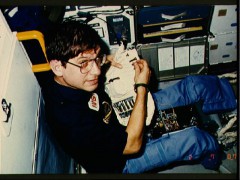
One of the primary objectives of RCA’s Bob Cenker was to observe the deployment of the powerful Satcom Ku-1 satellite (Credits: NASA).
For Cenker, who had served as RCA’s manager of systems engineering for the Satcom-K, it was “his” satellite and his technical responsibility. RCA paid NASA $14.2 million to launch Satcom K-1 on Mission 61C, and the satellite’s 16 transponders were expected to provide coverage of the entire contiguous United States. Confusingly, the second Satcom-K (“K-2″) was launched aboard Mission 61B, before K-1, and physically the satellites differed from many of their predecessors, in that they were cube-shaped, carried wing-like solar arrays, and were also much heavier. In fact, at more than 4,200 pounds (1,900 kg), the Satcom-Ks were several times heavier than most other commercial communications satellites previously deployed by the shuttle. This demanded a more powerful version of the Payload Assist Module (PAM) booster. Enter the new PAM-D2, which could accommodate heavier payloads measuring up to 10 feet in diameter, as opposed to just over six feet for its predecessor, the PAM-D.
The second payload specialist on 61C should have been Greg Jarvis, a Hughes engineer, selected by his company in the summer of 1984 and first attached to Dan Brandenstein’s Mission 51D. Unfortunately for Jarvis, as the manifest shape-shifted in early 1985, he moved further and further downstream. Since Hughes had built the Navy’s Syncom, it seemed likely that he would accompany one of those satellites into orbit, and he was earmarked to fly on Joe Engle’s Mission 51I for a while, before inexplicably disappearing from the crew roster and winding up on 61C. Then, in the autumn of 1985, Jarvis was moved again—this time to tragic Mission 51L. His place on 61C would be taken by Congressman Bill Nelson, a Democrat from Florida, and this reassignment—to a mission which did not even have a Hughes payload aboard—reinforced to many the reality that he had been moved simply to make room for a politician to fly.
High-flying Politics
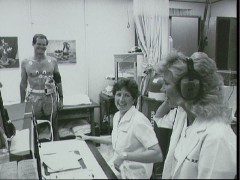
Congressman Bill Nelson undergoes medical tests in the JSC Clinic in September 1985 (Credits: NASA).
“Willie Nelson,” as chief astronaut John Young called him—“the one who can’t sing!”—had practiced law and served as an Army reservist before entering the Florida House of Representatives in 1972. He won re-election in 1974 and 1976 and served in the House of Representatives in Washington, D.C., from 1978 until 1991. At the time of Mission 61C, Nelson chaired the House’s Space Science and Technology Subcommittee. Today a senior senator for Florida, he has proven a staunch supporter of NASA over the years and one of the agency’s most vocal political champions.
However, Nelson’s assignment brought with it the inevitable question of what he should do in orbit. Photography seemed the most obvious option, although Nelson wanted to be assigned something more important. Principal investigators would spend many years, and in some cases many millions of dollars, preparing their experiments for flight and training the astronauts to operate them, and they were reluctant to have a non-technical politician step in at the last minute and possibly screw them up. Commander Hoot Gibson remained firm: mission specialists would operate the experiments. Some astronauts jokingly wondered if Nelson’s “important” experiment was to find a cure for cancer. In all sincerity, Nelson proposed that he take photographs of Africa to aid with the humanitarian effort. He also suggested a communications link between the shuttle and the cosmonauts aboard the Salyut 7 space station. Hearing of Nelson’s three “missions”—curing cancer, ending famine, and fostering better U.S.–Soviet relations—the astronaut office humorists quickly got in on the act, as noted by astronaut Mike Mullane in his memoir, Riding Rockets.
“Do you know how to ruin Nelson’s entire mission?” came the joke.
The response: “On launch morning, tell him they’ve found a cure for cancer, it’s raining a flood in Ethiopia, and the Berlin Wall is coming down! He’ll be crushed!”
Yet, as a crew member, Nelson proved a model payload specialist. “He worked very hard,” admitted Pinky Nelson. “Physically, he was in better shape than we were! He had no experience … in aviation or anything technical. He was a lawyer, but that didn’t stop him from trying, and I think he knew where his limitations were.” In fact, Pinky and Bill Nelson, though unrelated, became the first two men with the same surname to fly together in space.
Hoot’s Law
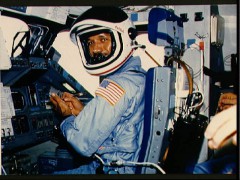
Pictured during preparations for re-entry at his station on Columbia’s flight deck, Pilot Charlie Bolden had learned through experience the intricacies of “Hoot’s Law” (Credits: NASA).
Assigned as 61C’s pilot, Charlie Bolden—today serving as NASA Administrator—would credit his commander with having taught him a great deal about shuttle systems and aerodynamics … and, most significantly, Hoot’s Law. By his own admission, Bolden struggled through his first few months of mission-specific training. “I really wanted to impress everybody on the crew and the training team,” he told the NASA oral historian. One day, in the simulator, the instructors threw an engine failure at the crew and, to distract them, quickly piled on more problems. Bolden followed his procedures, safing the engine, and was quickly presented with a minor glitch in an electrical bus. His attention shifted to the new problem, but he picked the wrong bus and inadvertently shut down the bus for an operating engine. “When I did that,” he said, “the engine lost power and it got real quiet! We went from having one engine down in the orbiter, which we could’ve gotten out of, to having two engines down, and we were in the water, dead.” Bolden felt awful. If this ascent simulation had been for real, he would have brought death to them all. Gibson, in his infinite wisdom, reached across the cockpit and patted Bolden on the shoulder.
“Charlie,” he said, “let me tell you about Hoot’s Law.”
“What’s Hoot’s Law?”
“No matter how bad things get, you can always make them worse!”
Readying for Launch
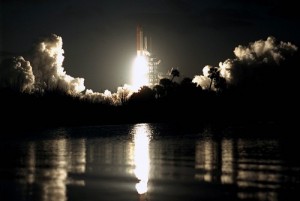
“Mission Impossible” finally launches as Columbia roars into the darkened Florida skies on 12 January 1986 (Credits: NASA).
On Mission 61C, launched on January 12, 1986; Space Shuttle Columbia was making her first orbital flight in over two years. Late in January 1984, a month after returning from her STS-9 mission, she was transported from Florida to California for a major program of upgrades at prime contractor Rockwell International’s plant in Palmdale. She received heads-up displays for her pilots, lost her original ejection seats in favor of lighter versions, and was equipped with new instruments—including a tail-mounted Shuttle Infrared Leeside Temperature Sensing (SILTS) pod—to monitor her performance during flight. Returned to the Cape in July 1985, she entered formal processing for Mission 61C in September, by which time the flight’s payload had changed again. The crew would retain their Materials Science Laboratory (MSL-2) payload and gain the Satcom Ku-2 communications satellite and a “bridge” of Getaway Special experiment canisters, but the remainder of their scheduled five days in orbit would be relatively roomy. To 61C crewman Steve Hawley, this provided every reason for NASA to cancel 61C … but for one thing: the presence of Congressman Bill Nelson.
“Frankly, our payload wasn’t very robust,” he told the NASA oral historian, “and were it not for [Nelson’s] presence on the flight, we might have been cancelled. We had one satellite and some other experiments. It was a clearing-house sale!” Mission 61C finally received a firm launch date of 18 December 1985, and should have been NASA’s 10th flight of the year, capping a triumphant run of shuttle achievements and heralding the dawn of an even brighter 1986. However, it did not happen. Launch on the 18th, scheduled for 7 a.m. EST, was postponed by 24 hours to give technicians more time to finish closing out Columbia’s aft compartment. The second effort to get the queen of the fleet airborne, on the 19th, ended dramatically just 14 seconds before launch, when flight controllers received an indication that the hydraulic power unit on the right-hand Solid Rocket Booster had exceeded allowable turbine speed limits. “We were happy as clams,” Charlie Bolden recalled of the build-up to that attempt. “All of a sudden, everything stopped and the countdown clock went back to T-9 [minutes] and kind of ticked there. We had no idea what had happened. As they started looking at the data, they had an indication that we had a problem with the right-hand booster.” The signal turned out to be erroneous, but by then the window had closed and the seven astronauts were obliged to disembark.
Launch was moved to 6 January 1986, and was under considerable pressure to get underway, because the next flight—Mission 51L—was due to fly from the newly-refurbished Pad 39B on the 22nd, carrying New Hampshire school teacher Christa McAuliffe as the nation’s first private-citizen astronaut. NASA also wanted Columbia back from 61C as quickly as possible, because she was booked for the ASTRO-1 mission to observe Halley’s Comet in early March. A launch on 18 or 19 December would have allowed just enough time to refurbish Columbia and install a battery of three ultraviolet telescopes for ASTRO-1. Delaying 61C past Christmas and into the New Year was a headache which the space agency could ill afford, but worse was to come.
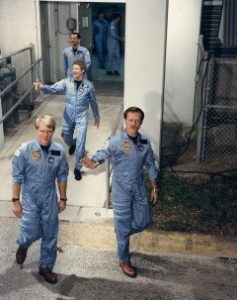
Robert “Hoot” Gibson (right) and George “Pinky” Nelson lead the 61C crew out of the Operations & Checkout Building for launch. Following is crewmate Steve Hawley (Credits: NASA).
For the crew, the festive period was a chance to relax after more than a year of intensive training in the simulators and uncertainty over when they would ever fly. “We stayed in quarantine a lot of the time,” remembered Steve Hawley in his NASA oral history. “When you’re in a launch mode, down in Florida, the pace is not very hectic. You’re not in training … like you would be if you’re in Houston and going to the simulators every day. You’re reviewing procedures and checklists and having a nice time, because you have the opportunity to sort of sit back without the pressure of having to be in a sim. I’ve always enjoyed the time in quarantine, although, because of the launch time, we were getting up at two in the morning every day!”
Stuck on the Pad
Columbia’s launch attempt on 6 January turned out to be one of the most hazardous yet in the shuttle’s five-year operational history. The count was halted at T-31 seconds, following the accidental draining of almost 4,000 pounds (1,800 kg) of liquid oxygen from the External Tank! The fill and drain valve, it seemed, had not properly closed when commanded to do so. Launch controllers reset the clock to T-20 minutes and efforts were made to reinitiate the liquid oxygen tanking, but it was quickly realized that time was running out and the window would close before the vehicle was ready. Another 24-hour delay was called. The next attempt, on the 7th, was scrubbed due to poor weather at two Transoceanic Abort Landing sites in Spain and Senegal.
Yet another try on the 9th similarly came to nothing when a liquid oxygen sensor on Pad 39A broke off and lodged itself in the prevalve of one of Columbia’s main engines. “That would have been a bad day,” pilot Charlie Bolden recalled, grimly, years later. “It would have been catastrophic, because the engine would have exploded, had we launched.” Heavy rain put paid to the next opportunity on 10 January, but on this occasion the seven-man crew was relieved. “We went down to T-31 seconds,” said Bolden, “and they went into a hold for weather and it was the worst thunderstorm I’d ever been in. We were really not happy about being there, because you could hear the lightning! You could hear stuff crackling in your headset. You’re sitting out there on the top of two million pounds of liquid hydrogen and liquid oxygen and two [SRBs]. None of us were enamoured with being out there.”
The repeated delays took a financial toll, too. Previously, astronauts were responsible for getting their families to Florida, paying their way, finding motel rooms for them, and putting them up. Crewman George “Pinky” Nelson’s wife, Susie, spent three weeks in a condo at Cape Canaveral, waiting, and their young children ended up missing the launch because they had missed so much school and went back to Houston. “Had the accident occurred on that flight, instead of the flight afterwards,” said Nelson, “it would have been just a nightmare scene, because the families were scattered all over the place.”
As for the cause of the delays, there could be only one person to blame: Steve Hawley.
When the astronauts left their quarters in the pre-dawn darkness of 12 January, Hawley had ridden the bus to the launch pad on 10 occasions for only two liftoffs. To this day, he is confident that a conversation and agreement he had with commander Robert “Hoot” Gibson may have helped to finally get Columbia into orbit. “I decided that if [Columbia] didn’t know it was me, then maybe we’d launch,” he said, “and so I taped my name tag with grey tape and had the glasses-nose-moustache disguise and wore that.” It worked and 61C roared into space at 6:55 a.m. EST. Yet misfortune was not done with the crew, as recounted dramatically by Bill Nelson in his book about the flight, Mission.
Liftoff and a Leak
Shortly after leaving the pad, Bolden noticed an ominous indication of a possible helium leak. An alarm sounded in the cockpit. “I looked down at what I could see,” Bolden said, “with everything shaking and vibrating, and we had an indication of a helium leak in the right-hand main engine. Had it been true, it was going to be a bad day.” The pilots communicated the information to Mission Control and advised them that they would work their procedures. “The ground didn’t see anything” on their data, Bolden continued. “It was a glitch in one of the computers.” He and Gibson attempted to isolate the first system, but there was no change. It still looked as if there was a leak. Isolating the second system, similarly, had no effect. “Then, I looked down, and it looked like we were making helium.” He told Gibson that it looked like a sensor problem, not a genuine leak. Gibson concurred and they reconfigured the system back to normal. It was an inauspicious start, for all this happened within seconds of liftoff.
Other than the malfunctioning helium sensor, Columbia’s seventh ascent was normal, although Bolden recalled that his first flight into space “went by really fast.” He has since downplayed his role in isolating the problem, but Bill Nelson, sitting on the middeck and listening to the communications through a headset, would later praise the pilot for “saving” the mission. “We had a problem,” Bolden admitted, “but it was an instrumentation problem.”
Finally in Space
As one of the few black astronauts, there was one particular place that Bolden wanted to see after reaching orbit: Africa. Years later, he would describe it as “awe-inspiring” and it brought tears to his eyes. However, his first glimpse of his ancestral homeland from space would closely mirror the reflections of many other astronauts: for there were no lines or boundaries to demarcate the countries or, indeed, the continents, and Bolden found it difficult to orient himself and realize what he was observing.
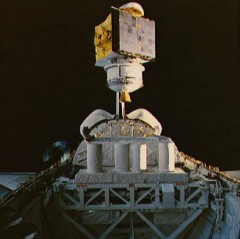
The cube-shaped Satcom Ku-1 payload—one of the most powerful communications satellites of its time—departs Columbia, affixed to a PAM-D2 booster (Credits: NASA).
Deployment of Satcom K-1 was supervised by Pinky Nelson and fellow astronaut Franklin Chang-Diaz and took place near the end of the first day in space. After several hours of checking out the payload, the satellite and its booster were released at 4:26:29 p.m. EST, a little under 10 hours into the mission. All went well, and Satcom finally achieved its geostationary “slot” at 85 degrees West longitude, where it remained operational until April 1997. It marked the last “major” commercial satellite to be launched by the shuttle, and the remainder of Mission 61C, in Hoot Gibson’s words, was “the end of innocence” for the reusable spacecraft.
The astronauts settled down to what should have been five days of experiments and observations of Halley’s Comet, which was making its closest approach to Earth since 1910. The Comet Halley Active Monitoring Program (CHAMP) required Nelson to bury himself under a black shroud to eliminate cabin light interference and take high-resolution photographs of the celestial wanderer. Much to Nelson’s annoyance, the camera failed due to a battery problem and did not even return one decent image of the comet. Although Nelson and his crewmates tried to repair CHAMP, their efforts were in vain, and by 14 January they were told to press on with the rest of their mission. Another attempt was scheduled for Challenger later in the month and then, in March, ASTRO-1 would conduct an ultraviolet analysis of Halley. However, the loss of Challenger and the stalling of the shuttle program meant that NASA lost its chance to capitalize on viewing the comet from space.
Stuck in Space But Prepared for Anything
If the factors which conspired to keep Columbia on the ground were maddening, those which hampered her return to Earth proved equally trying. Originally scheduled to touch down in Florida on 17 January—marking a return to operational use of the Shuttle Landing Facility after improvements to brakes and tires—the attempt was brought forward by a day to provide more time to prepare for ASTRO-1. However, bad weather in Florida forced a 24-hour delay. Another delay was implemented on the 17th, for the same reason. For Hoot Gibson, the time spent in orbital limbo was spent writing a song to the tune of Who Knows Where or When? He and Bolden sang it to Mission Control in a two-part harmony:
It seemed that we have talked like this before
The de-orbit burn that we copied then
But we can’t remember where or when
The clothes we’re wearing are the clothes we’ve worn
The food that we’re eating is getting hard to find
Since we can’t remember where or when
Some things that happened for the first time
Seem to be happening again
And so it seems we will de-orbit burn
Return to Earth and land, somewhere,
But who knows where or when?
Houston loved it and responded with a mock “Wanted” poster for all seven astronauts, calling for them to be returned to Earth immediately, if found.
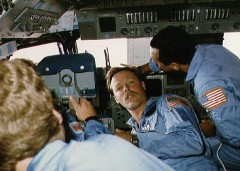
61C crewmen Steve Hawley, Robert “Hoot” Gibson (facing camera), and Charlie Bolden demonstrate the cramped nature of Columbia’s flight deck during the mission (Credits: NASA).
The first opportunity to land in Florida on 18 January was postponed by one orbit, and when NASA finally ran out of time Columbia had to be diverted to Edwards Air Force Base in California. “Everything worked, except God!” Charlie Bolden joked. “Finally, on our fifth attempted landing, in the middle of the night, we landed at Edwards, which was interesting because with a daytime scheduled landing, you’d have thought we wouldn’t be ready for that. Hoot, in his infinite wisdom, had decided that half our landing training was going to be nighttime, because you needed to be prepared for anything.”
Columbia touched down on Runway 22 at 5:58:51 a.m. PST, wrapping up a mission of a little more than six days. Subsequent inspections would reveal severe thermal damage to her right-hand main gear inboard brake, and it was decided that major improvements to withstand higher energy wear would be incorporated before her next voyage, Mission 61E. Coupled with the landing in California, this made the scheduled launch of 61E, just seven weeks later, increasingly untenable. “The landing,” said Bolden, was “uneventful, other than the fact that it really upset Congressman Nelson, because he really had these visions of landing in Florida and taking a Florida orange!” The recovery team at Edwards showed no mercy, and fellow astronaut Dan Brandenstein greeted the crew with a basket of California oranges and grapefruits from the California Growers’ Association! It was a joke that Nelson did not appreciate. Ten days later, he would appreciate, at least, that he had returned alive.
– By Ben Evans





































![A trajectory analysis that used a computational fluid dynamics approach to determine the likely position and velocity histories of the foam (Credits: NASA Ref [1] p61).](http://www.spacesafetymagazine.com/wp-content/uploads/2014/05/fluid-dynamics-trajectory-analysis-50x50.jpg)



Leave a Reply